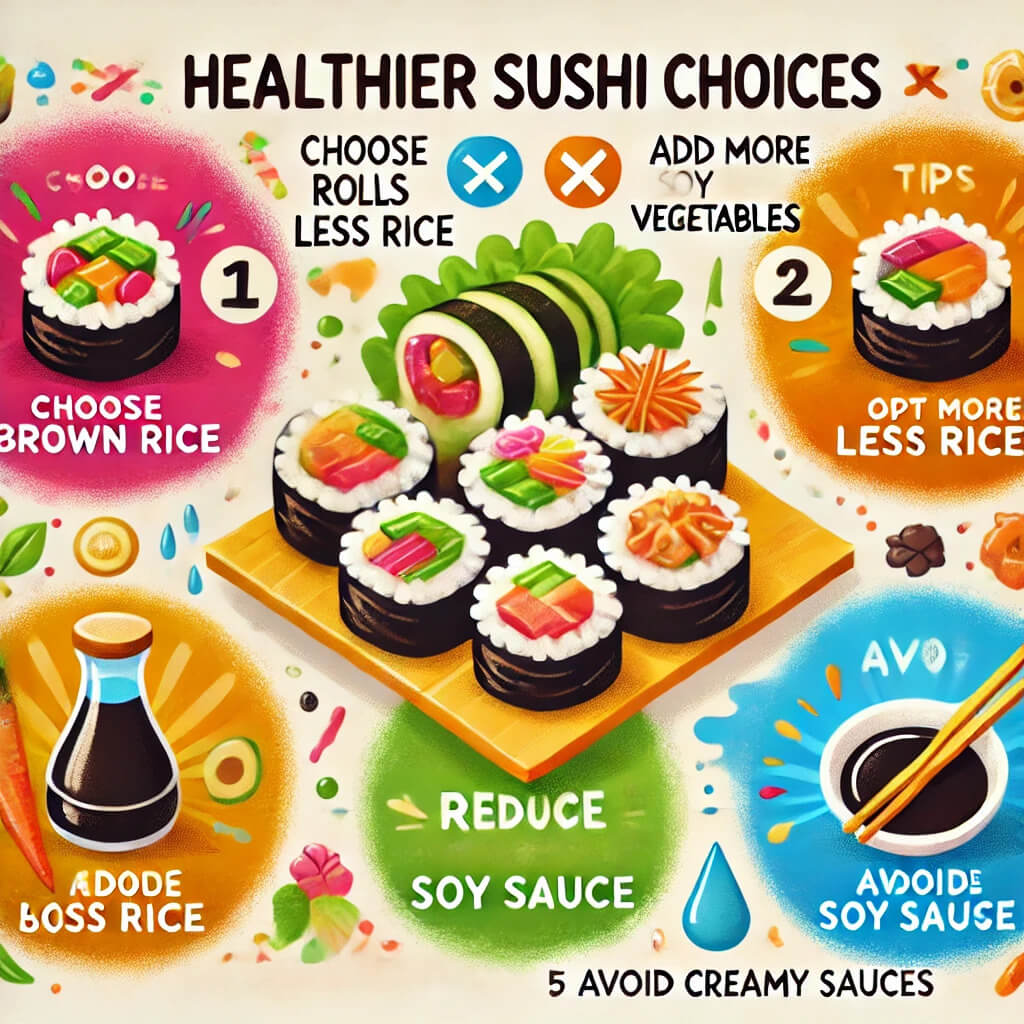Sushi Nutrition Facts: A Simple Guide to a Healthy Sushi Diet
Sushi Nutrition Facts: Sushi can be a healthy and tasty meal, but how healthy it is depends on the ingredients and type of sushi. Sushi Nutrition Facts are important to understand when choosing what type of sushi to eat. This guide will cover the calories, nutrients, vitamins, and minerals in sushi, along with the health benefits and risks. It will also give tips on making better choices when eating sushi.
Key Points
- Sushi nutrition depends on the type of sushi and the ingredients used.
- Sushi can be a good source of protein, healthy fats (omega-3s), and important vitamins and minerals.
- Some types of sushi can be high in calories, fat, or salt.
- Choosing healthier sushi options and watching portion sizes can help make sushi part of a balanced diet.
- Knowing about sushi’s nutrition and risks can help you make better choices.
Sushi Nutrition Facts
The nutrition of sushi can vary a lot depending on the ingredients used. Sushi Nutrition Facts can help you understand what nutrients you are getting from different types of sushi. Here’s an example of the average nutrition of a sushi roll (8 pieces):
| Nutrient | Amount | % Daily Value (DV) |
|---|---|---|
| Calories | 349 | – |
| Fat | 19g | 24% |
| Carbohydrates | 38g | 14% |
| Protein | 7.8g | – |
| Fiber | 3.2g | 13% |
| Sugar | 7g | – |
| Sodium | 537mg | 22% |
The calories in sushi rolls can change a lot based on the ingredients. Here are some popular sushi rolls and their calories:
| Sushi Roll | Calories |
|---|---|
| California roll | 93-628 |
| Spicy tuna roll | 175 |
| Spicy salmon roll | 190 |
| Shrimp tempura roll | 175 |
| Avocado roll | 140 |
| Rainbow roll | 146 |
| Philadelphia roll | 170 |
| Salmon avocado roll | 179 |
| Dragon roll | 175 |
| Cucumber roll | 78 |
| Spider roll | 214 |
The differences in calories depend on what is used in the roll, like fish, sauces, and extra toppings. Rolls with tempura (fried) or creamy sauces are higher in calories, while rolls with just vegetables or raw fish are usually lower in calories.

Sushi Nutrition: Vitamins and Minerals
Sushi can be a good source of different vitamins and minerals, such as:
- Vitamin D: Found in fish and seafood, helps keep bones healthy and supports the immune system.
- Vitamin B2 (Riboflavin): Found in fish, helps the body turn food into energy.
- Iron: Found in fish, seafood, and seaweed, helps carry oxygen in the blood.
- Zinc: Found in fish, seafood, and seaweed, helps the immune system and healing.
- Iodine: Found in seaweed, helps the thyroid work properly.
- Magnesium: Found in fish and seaweed, helps muscles and nerves work.
- Potassium: Found in fish and seaweed, helps control blood pressure.
- Calcium: Found in seaweed, helps keep bones strong.
- Vitamin A: Found in nori (seaweed), helps with vision and the immune system.
- Vitamin B1 (Thiamine): Found in nori, helps turn food into energy.
- Vitamin C: Found in nori, helps the immune system and keeps skin healthy.
- Vitamin E: Found in nori, works as an antioxidant and helps keep skin healthy.
Sushi Nutrition: Health Benefits
Boost your mental wellness by eating nutrient-rich foods like sushi, which has omega-3 fats and antioxidants.
Eating sushi can be good for your health because it has omega-3 fats, vitamins, and minerals. Understanding Sushi Nutrition Facts can help you see the health benefits of omega-3 fats, vitamins, and minerals found in sushi. Here are some of the health benefits:
- Reduces inflammation: Omega-3 fats in fish help lower inflammation, which is linked to many health issues, like heart disease.
- Lowers risk of heart disease and stroke: Omega-3 fats help improve cholesterol and lower blood pressure, which reduces the risk of heart problems.
- Anti-inflammatory properties: Wasabi and seaweed have anti-inflammatory properties that help the body.
- Helps fight viruses: Ginger, which is often served with sushi, has antiviral properties that may protect against infections.
- Removes heavy metals: Seaweed can help remove heavy metals from the body.
- Rich in antioxidants: Ingredients like ginger, nori, and wasabi contain antioxidants that help protect the body from damage.
- Supports brain health: Omega-3 fats are also good for brain health and may help reduce the risk of brain diseases.
Sushi Nutrition: Potential Risks
If you’re new to making healthy choices, you might also be interested in our home workout routine for beginners, which pairs well with a healthy diet like sushi.
Sushi Nutrition Facts can help you be aware of potential risks and make better choices. While sushi can be a healthy choice, there are some risks to keep in mind:
- Bacteria and parasites in raw fish: Raw fish can have bacteria or parasites that can make you sick. Always choose sushi from clean, trustworthy restaurants.
- Mercury in certain fish: Some fish, like tuna, have high levels of mercury, which can be harmful if eaten too often. Pregnant women and young children need to be especially careful.
- High sodium content: Some sushi, especially with soy sauce or pickled ingredients, can be high in salt. Too much salt can raise blood pressure.
- High-calorie ingredients: Some rolls have high-calorie ingredients like cream cheese, fried tempura, or mayo-based sauces, which can lead to weight gain if eaten too much.
Sushi Nutrition: Tips for Healthier Choices

Here are some tips to make sushi a healthier part of your diet: If you are also interested in at-home fitness, check out our home workouts guide for more ways to stay healthy. By keeping Sushi Nutrition Facts in mind, you can make healthier choices when eating sushi:
- Choose rolls with brown rice: Brown rice has more fiber and nutrients than white rice.
- Opt for hand rolls with less rice: Hand rolls usually have less rice, which means fewer calories.
- Add miso soup, edamame, or sashimi for protein and fiber: These can help fill you up without too many calories.
- Limit rolls with cream cheese, sauces, or tempura: These add extra calories, fat, and salt, so eat them in moderation.
- Use less soy sauce: Soy sauce has a lot of salt, so use it sparingly or choose a low-sodium version.
- Choose a trusted restaurant: Make sure the sushi place follows good food safety practices to avoid getting sick.
- Try cooked fish or vegetarian options: If you’re worried about raw fish, go for cooked fish or veggie rolls, like avocado or cucumber rolls.
- Add more vegetables: Look for rolls with veggies like cucumber, avocado, carrots, or bell peppers to boost nutrition.
- Balance your meal: Pair sushi with a side of veggies or a salad to add more fiber and nutrients.
- Watch portion sizes: Sushi pieces are small, and it’s easy to eat too many. Be mindful of how much you’re eating.
Conclusion: Is Sushi Healthy?
Sushi can be a healthy and nutritious meal if eaten carefully. It can also be a great addition to your overall wellness routine, along with practices like mindfulness exercises that support mental health. By choosing healthier options and being aware of the risks, you can enjoy sushi as part of a balanced diet. Eating a variety of ingredients, focusing on nutritious choices, and controlling portion sizes can help make sushi a healthy addition to your meals.
When choosing sushi, it’s important to think about the types of fish, the calories, and the salt content. By making good choices, you can enjoy sushi while staying healthy. Whether you like traditional rolls, sashimi, or hand rolls, there are many ways to make sushi fit your dietary needs.
FAQs
What are the health benefits of eating sushi regularly?
Eating sushi can also help you stay motivated to achieve your goals, as maintaining a healthy diet contributes to overall well-being and energy levels.
Eating sushi often can provide health benefits like reduced inflammation, lower risk of heart disease and stroke, and improved brain health. The omega-3 fats, vitamins, and minerals in sushi help with these benefits.
How does sushi compare nutritionally to other popular Japanese dishes?
Sushi is usually lower in calories and fat than other Japanese dishes like ramen or udon noodles. But it can be high in salt and sugar, especially if it has sauces or pickled ingredients. Compared to fried dishes like tempura, sushi can be a lighter and healthier choice, especially with fresh fish and veggies.
Low-Calorie Sushi Options
Are there any low-calorie sushi options for health-conscious eaters?
Yes, there are low-calorie options, like rolls with brown rice, hand rolls with less rice, and sashimi. Rolls with mostly veggies and lean fish, like cucumber rolls, avocado rolls, or tuna sashimi, are good choices for fewer calories.
What are the main nutritional differences between different types of sushi?
The main differences depend on the ingredients and how the sushi is made. Rolls with raw fish tend to be lower in calories and fat than rolls with cooked fish, especially if the fish is fried or served with creamy sauces. Veggie rolls are often lower in calories but may not have as many healthy fats as fish rolls. Rolls with brown rice have more fiber than those with white rice.
How to Make Healthy Sushi at Home
How can I make sushi at home with healthier ingredients?
To make healthier sushi at home, use brown rice, add less sugar and salt, and choose low-calorie fillings like cucumber, avocado, or lean fish. Add more veggies to make your rolls more nutritious. You can also use low-sodium soy sauce to reduce salt intake.






